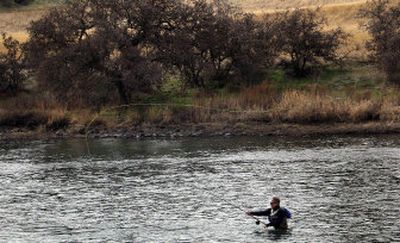LIGHTS & RODS

Eric Merchant traveled to the Clearwater River with hopes of landing one of its prized steelhead on a fly rod. It’s a challenge anglers from all over the world take on. They can spend many days trying and still leave empty-handed and humbled by the river’s elusive fish.
Merchant, of Helena, Mont., is a trout guide on the Missouri River. He decided to tip the odds a little more in his favor by hiring Jeff Jarrett of Orofino to help him learn the river and improve his fly casting.
Like many anglers, Merchant found the Clearwater intimidating.
“This is a big river and there is lots of water. I want to learn how to cast on it, and what to use, therefore, the guide,” he said. “People who (regularly) fish the river, know how to fish it.”
Merchant picked one of the most challenging ways to land a steelhead. He was fly fishing with a two-handed Spey rod, named after Scotland’s Spey River. Spey rods are popular for steelhead fishing because an angler can rollcast long distances with no backcast. A 12-foot Spey rod is considered short, and the standard for steelhead fishing is 13- or 14-foot rods. Some are as long as 16 feet.
The transition from a single-hand fly rod to a Spey rod does not come naturally, even for a seasoned fly angler like Merchant.
Under Jarrett’s instruction, Merchant’s Spey casting improved throughout the day, from tentative, often sloppy 60-foot casts, to deliberate and confident 70- and 80-footers.
“A few simple things changed the whole day,” Merchant said.
Casting is only one part of the equation. Hooking a steelhead is another matter.
Merchant fished all morning and into early afternoon without a single bump on his fly. Then on one random cast, the fly swung across the current just like it had hundreds of other times, but on this cast a steelhead decided to strike.
Merchant’s 14-foot rod nearly doubled over as the fish slashed through shallow water and made a run toward the depths.
Merchant fought the ocean-fresh fish back toward the shallows, but it had energy to spare and it sprinted away, stripping line and making his reel whine in protest.
Merchant patiently continued the tug-of-war with the steelhead, tiring it enough to land it, but not overplaying it to the point of exhaustion.
With a broad, adrenaline-induced grin, he admired the bright female steelhead, which Jarrett estimated was in the 8-pound range. It was the first one Merchant had caught on his Spey rod.
“I can’t believe that just happened,” he said. “I just took a steelhead on a swinging fly.”
Jarrett has seen this scene unfold dozens of times in nearly 20 years of steelhead guiding on the Clearwater.
It’s his home water. His family has lived on the river for three generations, and Jarrett grew up fishing the Clearwater and pursuing its famous steelhead.
“My ace in the hole is I’ve been on this river my whole life,” Jarrett said.
But he doesn’t play his cards close to his chest waders. Jarrett is open with fishing advice and information about the river.
He chuckles and shakes his head when asked his fishing secrets.
“There’s really nothing to hide,” he said. “If there was a secret, there would be a secret society or something.”
People need to learn the river, he said.
“Find a piece of water you like, learn it intimately, and it will treat you well,” Jarrett said. Anglers also need to accept the challenge of steelhead fishing and realize there are times they are going to get skunked, with or without a guide.
“Steelhead are tough to catch because you’re fishing a fish that doesn’t feed,” he said.
No one knows why a steelhead strikes a lure, fly or bait. After a steelhead enters freshwater, it lives on its stored fat and doesn’t have to eat to survive. There are many theories as to why a steelhead strikes when it’s not feeding, and those theories have filled books, research papers and been the topic of many bankside, boat and barroom debates.
Jarrett said the biggest mistake anglers make is overanalyzing why steelhead bite. “They’re trying to make science out of something where science doesn’t apply,” he said.
He encourages people to stick with the basics. Fish in water that is 2 feet to 8 feet deep and flowing at about walking speed. Fish close to the bank rather than trying to cast into the middle of the river. Look for underwater structure, such as boulders, drop-offs and rocky points where steelhead like to rest.
“Concentrate your efforts on that water, and you will catch fish,” he said.
Use gear that you’re confident in and stick with it. “The longer your stuff is in the water, the better off you will be,” he said. “It’s a matter of getting it in front of the fish more than anything else.”